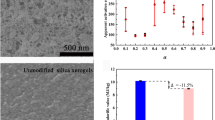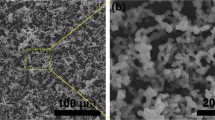Abstract
To reduce the flammability, hydrophobic silica aerogels (SAs) were modified by replacing commonly used trimethylchlorosilane (TMCS) with methyltrichlorosilane (MTCS). It was observed that the MTCS modified SAs (MSA) showed similar physicochemical properties to those TMCS modified SAs (TSA), including the density, thermal conductivity, hydrophobicity, and even thermal stability. However, the flammability of MSA was observed much lower than that of TSA, which was reflected by the significantly decreased gross calorific value (GCV). Furthermore, it was known from the kinetic and thermodynamic analyses that the pyrolysis of MSA became more difficult with the increasing conversion rate (α), which was evidenced by the fact that the apparent activation energy (E) kept rising to about 194 kJ/mol during the whole pyrolysis. Based on the changed E along the time, the pyrolysis process could be divided into two stages, in which α = 0.4 was considered as the turning point. Those main thermodynamic parameters, including pre-exponential factor (A) and the changes of enthalpy (ΔH) and entropy (ΔS), showed a quite consistent tendency with the E, whereas the change of Gibbs free energy (ΔG) almost kept unchanged. The research outcome of this study can provide a deep understanding of the pyrolysis process of SAs and render the public realize the thermal hazard risk of SAs.

Highlights
-
MTCS replaced TMCS to modify silica aerogels to reduce the flammability.
-
Gross calorific value of MTCS modified silica aerogels (MSA) decreased over 50%.
-
Kinetic and thermodynamic behaviors of MSA were studied in detail.
-
The pyrolysis of MSA was difficult to proceed along the time.
-
This study provided a technical basis for the thermal hazards of silica aerogels.






Similar content being viewed by others
References
Koebel M, Rigacci A, Achard P (2012) Aerogel-based thermal superinsulation: an overview. J Sol-Gel Sci Technol 63:315–339. https://doi.org/10.1007/s10971-012-2792-9
Liang Y, Wu H, Huang G, Yang J, Wang H (2017) Thermal performance and service life of vacuum insulation panels with aerogel composite cores. Energy Build 154:606–617. https://doi.org/10.1016/j.enbuild.2017.08.085
Yang J, Wu H, Huang G, Liang Y, Liao Y (2017) Modeling and coupling effect evaluation of thermal conductivity of ternary opacifier/fiber/aerogel composites for super-thermal insulation. Mater Des 133:224–236. https://doi.org/10.1016/j.matdes.2017.07.056
Zhu P, Zheng M, Zhao S, Wu J, Xu H, Novel A (2016) Environmental route to ambient pressure dried thermal insulating silica aerogel via recycled coal gangue. Adv Mater Sci Eng 2016:1–9. https://doi.org/10.1155/2016/9831515
Stahl T, Brunner S, Zimmermann M, Wakili KGhazi (2012) Thermo-hygric properties of a newly developed aerogel based insulation rendering for both exterior and interior applications. Energy Build 44:114–117. https://doi.org/10.1016/j.enbuild.2011.09.041
Galliano R, Ghazi Wakili K, Stahl T, Binder B, Daniotti B (2016) Performance evaluation of aerogel-based and perlite-based prototyped insulations for internal thermal retrofitting: HMT model validation by monitoring at demo scale. Energy Build 126:275–286. https://doi.org/10.1016/j.enbuild.2016.05.021
Reynolds JohnG, Coronado PaulR, Hrubesh LawrenceW (2001) Hydrophobic aerogels for oil-spill clean up – synthesis and characterization. J Non-Cryst Solids 292:127–137. https://doi.org/10.1016/S0022-3093(01)00882-1
He S, Cheng X, Li Z, Shi X, Yang H, Zhang H (2016) Green and facile synthesis of sponge-reinforced silica aerogel and its pumping application for oil absorption. J Mater Sci 51:1292–1301. https://doi.org/10.1007/s10853-015-9427-9
Wang Q, Yu M, Chen G, Chen Q, Tian J (2017) Robust fabrication of fluorine-free superhydrophobic steel mesh for efficient oil/water separation. J Mater Sci 52:2549–2559. https://doi.org/10.1007/s10853-016-0548-6
Yu Y, Wu X, Fang J (2015) Superhydrophobic and superoleophilic “sponge-like” aerogels for oil/water separation. J Mater Sci 50:5115–5124. https://doi.org/10.1007/s10853-015-9034-9
Wu J, Yang H (2013) Platinum-based oxygen reduction electrocatalysts. Acc Chem Res 46:1848–1857. https://doi.org/10.1021/ar300359w
Randall JP, Meador MAB, Jana SC (2011) Tailoring mechanical properties of aerogels for aerospace applications. ACS Appl Mater Interfaces 3:613–626. https://doi.org/10.1021/am200007n
Maghsoudi K, Motahari S (2018) Mechanical, thermal, and hydrophobic properties of silica aerogel-epoxy composites. J Appl Polym Sci 135:45706. https://doi.org/10.1002/app.45706
Ma J, Ye F, Yang C, Ding J, Lin S, Zhang B, Liu Q (2017) Heat-resistant, strong alumina-modified silica aerogel fabricated by impregnating silicon oxycarbide aerogel with boehmite sol. Mater Des 131:226–231. https://doi.org/10.1016/j.matdes.2017.06.036
Han Y, Zhang X, Wu X, Lu C (2015) Flame retardant, heat insulating cellulose aerogels from waste cotton fabrics by in situ formation of magnesium hydroxide nanoparticles in cellulose gel nanostructures, ACS sustain. Chem Eng 3:1853–1859. https://doi.org/10.1021/acssuschemeng.5b00438
Wang L, Sánchez-Soto M, Maspoch ML (2013) Polymer/clay aerogel composites with flame retardant agents: mechanical, thermal and fire behavior. Mater Des 1980-2015 52:609–614. https://doi.org/10.1016/j.matdes.2013.05.096
Chen H-B, Wang Y-Z, Schiraldi DA (2014) Preparation and flammability of poly(vinyl alcohol) composite aerogels. ACS Appl Mater Interfaces 6:6790–6796. https://doi.org/10.1021/am500583x
Wang Y-T, Liao S-F, Shang K, Chen M-J, Huang J-Q, Wang Y-Z, Schiraldi DA (2015) Efficient approach to improving the flame retardancy of poly(vinyl alcohol)/clay aerogels: incorporating piperazine-modified ammonium polyphosphate. ACS Appl Mater Interfaces 7:1780–1786. https://doi.org/10.1021/am507409d
Siligardi C, Miselli P, Francia E, Gualtieri MLassinantti (2017) Temperature-induced microstructural changes of fiber-reinforced silica aerogel (FRAB) and rock wool thermal insulation materials: a comparative study. Energy Build 138:80–87. https://doi.org/10.1016/j.enbuild.2016.12.022
Motahari S, Motlagh GH, Moharramzadeh A (2015) Thermal and flammability properties of polypropylene/silica aerogel composites. J Macromol Sci Part B 54:1081–1091. https://doi.org/10.1080/00222348.2015.1078619
Ghazi Wakili K, Remhof A (2017) Reaction of aerogel containing ceramic fibre insulation to fire exposure: reaction of aerogel containing insulation to fire. Fire Mater 41:29–39. https://doi.org/10.1002/fam.2367
Kashiwagi T, Gilman JW, Butler KM, Harris RH, Shields JR, Asano A (2000) Flame retardant mechanism of silica gel/silica. Fire Mater 24:277–289. https://doi.org/10.1002/1099-1018(200011/12)24:6<277::AID-FAM746>3.0.CO;2-A
Li Z, Cheng X, Gong L, Liu Q, Li S (2018) Enhanced flame retardancy of hydrophobic silica aerogels by using sodium silicate as precursor and phosphoric acid as catalyst. J Non-Cryst Solids 481:267–275. https://doi.org/10.1016/j.jnoncrysol.2017.10.053
Li Z, Cheng X, Shi L, He S, Gong L, Li C, Zhang H (2016) Flammability and oxidation kinetics of hydrophobic silica aerogels. J Hazard Mater 320:350–358. https://doi.org/10.1016/j.jhazmat.2016.07.054
Mahadik SA, Pedraza F, Parale VG, Park H-H (2016) Organically modified silica aerogel with different functional silylating agents and effect on their physico-chemical properties. J Non-Cryst Solids 453:164–171. https://doi.org/10.1016/j.jnoncrysol.2016.08.035
Rao AV, Pajonk GM, Bhagat SD, Barboux P (2004) Comparative studies on the surface chemical modification of silica aerogels based on various organosilane compounds of the type RnSiX4−n. J Non-Cryst Solids 350:216–223. https://doi.org/10.1016/j.jnoncrysol.2004.06.034
Mahadik DB, Rao AV, Rao AP, Wagh PB, Ingale SV, Gupta SC (2011) Effect of concentration of trimethylchlorosilane (TMCS) and hexamethyldisilazane (HMDZ) silylating agents on surface free energy of silica aerogels. J Colloid Interface Sci 356:298–302. https://doi.org/10.1016/j.jcis.2010.12.088
Li Z, Cheng X, He S, Shi X, Yang H (2015) Characteristics of ambient-pressure-dried aerogels synthesized via different surface modification methods. J Sol-Gel Sci Technol 76:138–149. https://doi.org/10.1007/s10971-015-3760-y
He F, Zhao H, Qu X, Zhang C, Qiu W (2009) Modified aging process for silica aerogel. J Mater Process Technol 209:1621–1626. https://doi.org/10.1016/j.jmatprotec.2008.04.009
Nadargi DY, Kalesh RR, Rao AV (2009) Rapid reduction in gelation time and impregnation of hydrophobic property in the tetraethoxysilane (TEOS) based silica aerogels using NH4F catalyzed single step sol–gel process. J Alloy Compd 480:689–695. https://doi.org/10.1016/j.jallcom.2009.02.027
Turmanova SC, Genieva SD, Dimitrova AS, Vlaev LT (2008) Non-isothermal degradation kinetics of filled with rise husk ash polypropene composites. Express Polym Lett 2:133–146. https://doi.org/10.3144/expresspolymlett.2008.18
Chen Y, Wang Q (2007) Thermal oxidative degradation kinetics of flame-retarded polypropylene with intumescent flame-retardant master batches in situ prepared in twin-screw extruder. Polym Degrad Stab 92:280–291. https://doi.org/10.1016/j.polymdegradstab.2006.11.004
Vlaev LT, Georgieva VG, Genieva SD (2007) Products and kinetics of non-isothermal decomposition of vanadium(IV) oxide compounds. J Therm Anal Calorim 88:805–812. https://doi.org/10.1007/s10973-005-7149-y
Ozawa T (1992) Estimation of activation energy by isoconversion methods. Thermochim Acta 203:159–165. https://doi.org/10.1016/0040-6031(92)85192-X
M Sharara, S Sadaka (2014) Thermogravimetric analysis of swine manure solids obtained from farrowing, and growing-finishing farms, J Sustain Bioenergy Syst 2014. https://doi.org/10.4236/jsbs.2014.41008.
Starink MJ (1996) A new method for the derivation of activation energies from experiments performed at constant heating rate. Thermochim Acta 288:97–104. https://doi.org/10.1016/S0040-6031(96)03053-5
Xu Y, Chen B (2013) Investigation of thermodynamic parameters in the pyrolysis conversion of biomass and manure to biochars using thermogravimetric analysis. Bioresour Technol 146:485–493. https://doi.org/10.1016/j.biortech.2013.07.086
Maia AAD, de Morais LC (2016) Kinetic parameters of red pepper waste as biomass to solid biofuel. Bioresour Technol 204:157–163. https://doi.org/10.1016/j.biortech.2015.12.055
Kim YS, Kim YS, Kim SH (2010) Investigation of thermodynamic parameters in the thermal decomposition of plastic waste−waste lube oil compounds. Environ Sci Technol 44:5313–5317. https://doi.org/10.1021/es101163e
Wu X, Fan M, Shen X, Cui S, Tan G (2018) Silica aerogels formed from soluble silicates and methyl trimethoxysilane (MTMS) using CO2 gas as a gelation agent. Ceram Int 44:821–829. https://doi.org/10.1016/j.ceramint.2017.10.005
Cheng X, Li C, Shi X, Li Z, Gong L, Zhang H (2017) Rapid synthesis of ambient pressure dried monolithic silica aerogels using water as the only solvent. Mater Lett 204:157–160. https://doi.org/10.1016/j.matlet.2017.05.107
He S, Sun G, Cheng X, Dai H, Chen X (2017) Nanoporous SiO 2 grafted aramid fibers with low thermal conductivity. Compos Sci Technol 146:91–98. https://doi.org/10.1016/j.compscitech.2017.04.021
Gurav JL, Rao AV, Rao AP, Nadargi DY, Bhagat SD (2009) Physical properties of sodium silicate based silica aerogels prepared by single step sol–gel process dried at ambient pressure. J Alloy Compd 476:397–402. https://doi.org/10.1016/j.jallcom.2008.09.029
Mahadik DB, Venkateswara Rao A, Parale VG, Kavale MS, Wagh PB, Ingale SV, Gupta SC (2011) Effect of surface composition and roughness on the apparent surface free energy of silica aerogel materials. Appl Phys Lett 99:104104. https://doi.org/10.1063/1.3635398
Sing KSW (1985) Reporting physisorption data for gas/solid systems-with special reference to the determination of surface area and porosity. Pure Appl Chem 57:603–619. https://doi.org/10.1351/pac198557040603
Rojas F, Kornhauser I, Felipe C, Esparza JM, Cordero S, Dominguez A, Riccardo JL (2002) Capillary condensation in heterogeneous mesoporous networks consisting of variable connectivity and pore-size correlation. Phys Chem Chem Phys 4:2346–2355. https://doi.org/10.1039/b108785a
Lermontov SA, Malkova AN, Yurkova LL, Straumal EA, Gubanova NN, Baranchikov AY, Ivanov VK (2014) Diethyl and methyl-tert-buthyl ethers as new solvents for aerogels preparation. Mater Lett 116:116–119. https://doi.org/10.1016/j.matlet.2013.10.080
Li Z, Cheng X, He S, Shi X, Yang H, Zhang H (2016) Tailoring thermal properties of ambient pressure dried MTMS/TEOS co-precursor aerogels. Mater Lett 171:91–94. https://doi.org/10.1016/j.matlet.2016.02.025
Wu G, Yu Y, Cheng X, Zhang Y (2011) Preparation and surface modification mechanism of silica aerogels via ambient pressure drying. Mater Chem Phys 129:308–314. https://doi.org/10.1016/j.matchemphys.2011.04.003
Li Z, Cheng X, Shi L, He S, Gong L, Li C, Zhang H (2016) Flammability and oxidation kinetics of hydrophobic silica aerogels. J Hazard Mater 320:350–358. https://doi.org/10.1016/j.jhazmat.2016.07.054
S He, Y Huang, G Chen, M Feng, H Dai, B Yuan, X Chen (2018) Effect of heat treatment on hydrophobic silica aerogel. J Hazard Mater. https://doi.org/10.1016/j.jhazmat.2018.08.087.
Zhuravlev LT (2000) The surface chemistry of amorphous silica. Zhuravlev model. Colloids Surf Physiochem Eng Asp 173:1–38. https://doi.org/10.1016/S0927-7757(00)00556-2
Yuan X, He T, Cao H, Yuan Q (2017) Cattle manure pyrolysis process: kinetic and thermodynamic analysis with isoconversional methods. Renew Energy 107:489–496. https://doi.org/10.1016/j.renene.2017.02.026
Kim YS, Kim YS, Kim SH (2010) Investigation of thermodynamic parameters in the thermal decomposition of plastic waste−waste lube oil compounds. Environ Sci Technol 44:5313–5317. https://doi.org/10.1021/es101163e
Ruvolo-Filho A, Curti PS (2006) Chemical kinetic model and thermodynamic compensation effect of alkaline hydrolysis of waste poly(ethylene terephthalate) in nonaqueous ethylene glycol solution. Ind Eng Chem Res 45:7985–7996. https://doi.org/10.1021/ie060528y
Matin SS, Chelgani SC (2016) Estimation of coal gross calorific value based on various analyses by random forest method. Fuel 177:274–278. https://doi.org/10.1016/j.fuel.2016.03.031
Llorente MJF, García JEC (2008) Suitability of thermo-chemical corrections for determining gross calorific value in biomass. Thermochim Acta 468:101–107. https://doi.org/10.1016/j.tca.2007.12.003
Mancini M, Rinnan A, Pizzi Å, Toscano G (2018) Prediction of gross calorific value and ash content of woodchip samples by means of FT-NIR spectroscopy Fuel Process Technol 169:77–83. https://doi.org/10.1016/j.fuproc.2017.09.021
Rhén C (2004) Chemical composition and gross calorific value of the above-ground biomass components of young Picea abies, Scand. J For Res 19:72–81. https://doi.org/10.1080/02827580310019185
Acknowledgements
This work was supported by the Fundamental Research Funds for the Central Universities (grant number 202501003, 202045001 and 502211841).
Author information
Authors and Affiliations
Corresponding author
Ethics declarations
Conflict of interest
The authors declare that they have no conflict of interest.
Rights and permissions
About this article
Cite this article
Zhang, W., Li, Z., Shi, L. et al. Methyltrichlorosilane modified hydrophobic silica aerogels and their kinetic and thermodynamic behaviors. J Sol-Gel Sci Technol 89, 448–457 (2019). https://doi.org/10.1007/s10971-018-4882-9
Received:
Accepted:
Published:
Issue Date:
DOI: https://doi.org/10.1007/s10971-018-4882-9




